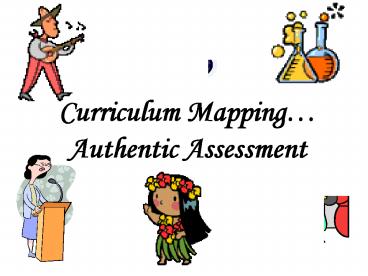Curriculum Mapping Authentic Assessment - PowerPoint PPT Presentation
1 / 17
Title:
Curriculum Mapping Authentic Assessment
Description:
What is the difference between assessment and evaluation? Why ... Recital. Debate. Game. Dance. Reading. Routine. Supporting Documents. Rubric. Answer Sheet ... – PowerPoint PPT presentation
Number of Views:53
Avg rating:3.0/5.0
Title: Curriculum Mapping Authentic Assessment
1
Curriculum MappingAuthentic Assessment
2
SKILLS STANDARDS
UNIT CONTENT
ASSESSMENT
3
Think Pair - Share
- What is the difference between assessment and
evaluation? - Why have assessments and evaluations?
- What Do You Mean By Understanding?
- What would You See/Hear Students Doing If They
- Understand?
4
Assessment verses Evaluation
- Be Aware!
- Difference between
- Assessment
- (product or performance)
- Evaluation
- (a given value for the product or performance)
5
Evidence of Understanding
- Can students..
- ? Explain It Accurately
- ? Give their interpretation
- ? Take anothers perspective
- ? Empathize Collaborate
- ? Ask Further Questions
6
Taking a look at assessments
7
Assessments
- Defined as Nouns
- Two Types
- Summative At a stagethe sum of learning that
verifies up to that point of learning. - Formative An informal check of learning wherein
student interaction and motivation are crucial
for learning. - Matched to Unit/Content Skills
8
Defined as a noun and as a name
- Every Content/Skill should be aligned to an
Assessment - Example
- Content A. Order of Operations
- Skill A1. Compared and Contrasted 3-step
problems with/without using the correct order of
operations - Assessment A1. 25 Problem (Chapter 4) Test
- the assessment must be well defined
- so that it describes the nature or basic quality
of the assessment. - Example
- 15 MC/Open-Ended Question
- (Chapter 3) Test
- Or
- Song Interpretation of the Order of Operations
(Rubric)
9
Three Levels of Assessment
- 1.
- Drill Practice
- 2.
- Rehearsal Scrimmage
- 3.
- Authentic Performance
10
Select Appropriate Assessment
- Traditional Tests
- Paper/Pencil
- Selected Response
- Constructed Response
11
Tangible Products
- A piece of writing
- A picture
- A spread sheet
- A model
- A photograph
- A puppet
- A blueprint
12
Observable Performances
- Speech
- Recital
- Debate
- Game
- Dance
- Reading
- Routine
13
Supporting Documents
- Rubric
- Answer Sheet
- Video
- Oral Presentation Tape
- Model
- Diagram
- Report
- Written Response to prompt
- Report Card
14
What if there is not formal assessment
- Write, there is
- NO
- formal assessment at this time!
15
16 Habits of Mind
- Persisting
- Managing Impulsivity
- Listening with understanding Empathy
- Thinking flexibly
- Thinking about Thinking
- Striving for Accuracy
- Questioning Posing Problems
- Applying Past Knowledge to new structures
16
16 Habits of Mind
- Thinking Communicating with clarity and
precision - Gathering data through all senses
- Creating, imagining, innovating
- Responding with wonderment and awe
- Taking responsible risks
- Finding Humor
- Thinking Interdependently
- Remaining open to continuous learning
17
Impact of poor backward planning
Results In
Lack of
- Vision Confusion
- Skills Anxiety
- Incentive Gradual of no Change
- Resources Frustration
- Action Plan False Starts
- Assessment Failure to Understand































